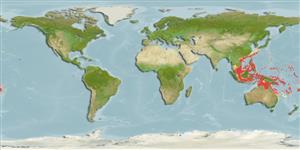Classification / Names
Common names from other countries
Main reference
Size / Weight / Age
Max length : 300 cm TL male/unsexed; (Ref. 58048)
Length at first maturity
Lm ?, range 155 - ? cm
Environment
Marine; demersal; depth range 0 - 60 m (Ref. 106604)
Climate / Range
Subtropical, preferred ?
Distribution
Western Pacific: Gulf of Thailand and the Philippines to Queensland, Australia. A similar and perhaps identical species occurs in the western Indian Ocean off Mozambique and in the Gulf of Aden and is probably sympatric with the true 'Rhynchobatus djiddensis' of the western Indian Ocean and the Red Sea. Distributional range probably wider than reported, but many nominal records of Rhynchobatus djiddensis from the western Pacific and southeastern Indian Ocean cannot be identified to species.
Countries | FAO areas | Ecosystems | Occurrences | Introductions
IUCN Red List Status (Ref. 115185)
Threat to humans
Harmless
Human uses
Fisheries: commercial
More information
Age/Size
Growth
Length-weight
Length-length
Length-frequencies
Morphometrics
Morphology
Larvae
Larval dynamics
Recruitment
Abundance
ReferencesAquacultureAquaculture profileStrainsGeneticsAllele frequenciesHeritabilityDiseasesProcessingMass conversion
Tools
Special reports
Download XML
Internet sources
Estimates of some properties based on models
Phylogenetic diversity index
PD50 = 0.5049 many relatives (e.g. carps) 0.5 - 2.0 few relatives (e.g. lungfishes)
Trophic Level
3.5 ±0.50 se; Based on food items.
Resilience
Low, minimum population doubling time 4.5 - 14 years (Fec assumed to be <100)
Vulnerability
Very high vulnerability (85 of 100)
Price category
